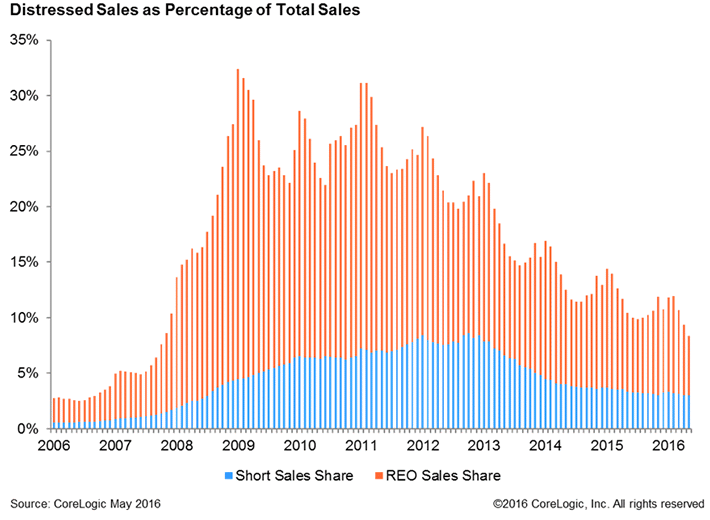The share of total home sales made up by distressed properties is now one-quarter the level it was in January 2009. CoreLogic reports that in May the total of foreclosed homes and houses sold through a short sale was 8.4 percent with foreclosures accounting for 5.4 percent of the total. On a month-over-month basis the distressed shares were down 1 percentage point from April and 2.1 points below the May 2015 level.
At the peak, distressed homes sales, made up 32.4 percent of the residential market, with foreclosures accounting for a 27.9 percent share. CoreLogic notes there will always be some level of distress in the housing market, with the pre-crisis share of sales generally running around 2 percent. If the current year-over-year decrease in the distressed sales share continues, the company expects it will reach that "normal" 2-percent mark in mid-2019. We believe this is the first time CoreLogic has pushed that projection out into 2019. Over the last year it has variously predicted a return to pre-crash levels by mid-2017 or mid-2018.
Sales from bank-owned real estate (REO) had the smallest share of any May since 2007. Short sales have remained in the 3 to 4 percent range in terms of share since mid-2014.

All but eight states recorded lower distressed sales shares in May 2016 that they did in the prior May. Maryland had the highest share at 19.4 percent followed by Connecticut (18.5 percent), Michigan (17.8 percent), Illinois (16 percent) and Florida (15.8 percent).
Despite continued turmoil in the energy markets, major oil states continued to see year-over-year declines in distressed sales. Texas was down 1.3 percentage point, and Oklahoma and North Dakota both saw a 0.1 percentage point decrease. Florida had had the most significant decline of any state, down 5.5 percentage points from a year earlier.
Baltimore was highest among the 25 largest Core Based Statistical Areas (CBSAs) with a distressed sales share of 19.2 percent. Chicago (18.1 percent), Tampa-St. Petersburg-Clearwater, at 17.3 percent, Orlando (16.4 percent) and St Louis, Missouri rounded out the top five.







